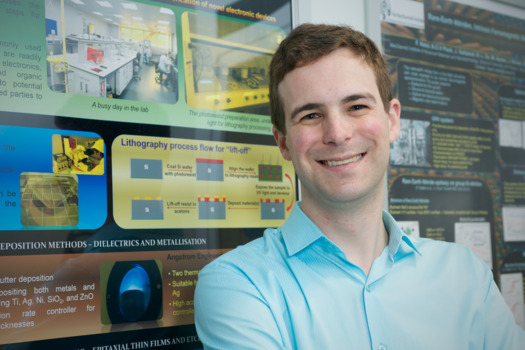Superlens promises new insights
28 Sep 2015 - 11:09:40 in Research
 Observing the real-time interaction of virus particles is one of the many benefits expected from Victoria University of Wellington research into the design of a new far-field superlens, or optical omniscope.
Dr Ciaran Moore from the School of Engineering and Computer Science will be leading the project as the recipient of a $300,000 Marsden Fast-Start grant.
Current superlens microscopes cannot simultaneously resolve both very small and large features, measured in terms of smaller or greater than 1/200th of the width of human hair. Moreover, they can only observe these features in one dimension, resulting in images consisting of parallel lines.
The optical omniscope aims to address both these issues, meaning differently-sized features can be observed together and in two dimensions, allowing for more detailed observations of nanostructures and nanoparticles interacting with their environment.
"The optical lenses we have now can only give us a blurry image of a nanostructure. It's like looking at an object through frosted glass. You can see that something is there, but not the finer detail," says Dr Moore.
"Other techniques with higher resolution are available, but these can damage the nanostructures."
While still in the early stages of development, Dr Moore says the optical omniscope has a number of potential benefits across a range of scientific applications.
"Presently, medical samples have to be extensively treated—usually cut into thin slices then bleached or doped with fluorescent markers—before they can be examined. But the optical omniscope removes the need for pre-treating, which will save time and result in faster diagnoses.
"Pre-treating can also kill medical samples—by eliminating the need to pre-treat, the sample remains live. That means you could take high-resolution images of a living sample and watch organisms develop or change over time, or see what happens to them when they are in contact with toxic material."
Dr Moore says the optical omniscope could also help speed up the manufacture of computer processors. "The wide field of view contains information about both the very small features as well as the larger ones, so you would be able to check a larger section of each microchip more quickly. By being able to manufacture them more quickly, the cost should then come down too."
Dr Moore hopes that the prototype optical omniscope will improve access to high-end microscopy equipment, thereby leading to new discoveries in nanoscience and nanotechnology.
"If we can make this technology better and more accessible, then more is being seen, which could have a significant impact on the rate of scientific discoveries."
Dr Moore has been working with Victoria University's School of Chemical and Physical Sciences, where nanoscience research is undertaken.
Marsden Fast-Start grants are administered by the Royal Society of New Zealand and come from a special pool of funds set aside for emerging researchers (up to seven years after the conferment of a PhD).
For more information contact Ciaran Moore on 04-463 5233 x8931 or ciaran.moore@ecs.vuw.ac.nz
Observing the real-time interaction of virus particles is one of the many benefits expected from Victoria University of Wellington research into the design of a new far-field superlens, or optical omniscope.
Dr Ciaran Moore from the School of Engineering and Computer Science will be leading the project as the recipient of a $300,000 Marsden Fast-Start grant.
Current superlens microscopes cannot simultaneously resolve both very small and large features, measured in terms of smaller or greater than 1/200th of the width of human hair. Moreover, they can only observe these features in one dimension, resulting in images consisting of parallel lines.
The optical omniscope aims to address both these issues, meaning differently-sized features can be observed together and in two dimensions, allowing for more detailed observations of nanostructures and nanoparticles interacting with their environment.
"The optical lenses we have now can only give us a blurry image of a nanostructure. It's like looking at an object through frosted glass. You can see that something is there, but not the finer detail," says Dr Moore.
"Other techniques with higher resolution are available, but these can damage the nanostructures."
While still in the early stages of development, Dr Moore says the optical omniscope has a number of potential benefits across a range of scientific applications.
"Presently, medical samples have to be extensively treated—usually cut into thin slices then bleached or doped with fluorescent markers—before they can be examined. But the optical omniscope removes the need for pre-treating, which will save time and result in faster diagnoses.
"Pre-treating can also kill medical samples—by eliminating the need to pre-treat, the sample remains live. That means you could take high-resolution images of a living sample and watch organisms develop or change over time, or see what happens to them when they are in contact with toxic material."
Dr Moore says the optical omniscope could also help speed up the manufacture of computer processors. "The wide field of view contains information about both the very small features as well as the larger ones, so you would be able to check a larger section of each microchip more quickly. By being able to manufacture them more quickly, the cost should then come down too."
Dr Moore hopes that the prototype optical omniscope will improve access to high-end microscopy equipment, thereby leading to new discoveries in nanoscience and nanotechnology.
"If we can make this technology better and more accessible, then more is being seen, which could have a significant impact on the rate of scientific discoveries."
Dr Moore has been working with Victoria University's School of Chemical and Physical Sciences, where nanoscience research is undertaken.
Marsden Fast-Start grants are administered by the Royal Society of New Zealand and come from a special pool of funds set aside for emerging researchers (up to seven years after the conferment of a PhD).
For more information contact Ciaran Moore on 04-463 5233 x8931 or ciaran.moore@ecs.vuw.ac.nz
